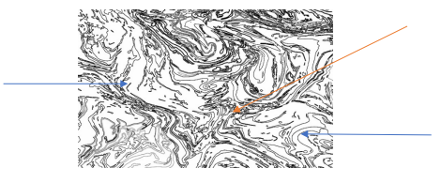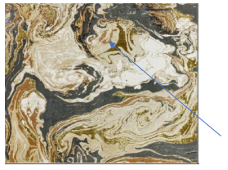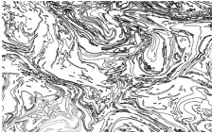
In Kai Collective Ltd v Honeygirl Co. Ltd (O-0117/23), Kai Collective Ltd (‘Proprietor’) was the owner of UK registered designs (‘RD’) #001-006 for marble patterns. Honeygirl Co. Ltd (‘Applicant’) filed an invalidation application against these RDs.
|
RD #001
|
RD #002
|
RD #003
|
|
RD #004
|
RD #005
|
RD #006
|
The Applicant relied on S.11ZA(1)(b) Registered Designs Act 1949 that the RDs did not meet the requirements of S.1(b) that a design shall be new and have individual character. The Applicant provided over 50 designs as prior art which it claimed were made available to the public before the application date and which either differed only in immaterial detail or gave the same overall impression.
The contested RDs
The Registrar first discussed the extent of protection which embodies the RDs. She commented that, though the representation of the designs are in a rectangular square, this presumably does not form part of the extent of protection but merely a convenient way of depicting the designs, which can be applied to any product of any shape. Notwithstanding, the Registrar lifted from Magnetic v PMS[1] that a design right “applicant should appreciate that it will almost always be those images which exclusively identify the nature and extent of the monopoly which he is claiming”.
RDs #001 and #002 are not in colour and therefore in comparing these with the prior art, the Registrar disregarded colour in the prior art. Given the designs are not protected for any particular products, the orientation of the designs, as well as of the prior art, was also disregarded in the comparisons.
Prior art
The claimed prior art included examples of marbled patterns as used in books, paper, fashion, homeware, and art. The earliest design relied upon was used in a book produced in Spain in 1570.
|
Examples of the claimed prior art |
It is for a proprietor to raise an exception under S.1(b)(6) that a prior art could not reasonably have become known before the relevant date in the normal course of business. However, since the Proprietor here did not raise that a design from 1570 Spain could not have been known in the normal course of business, the Registrar accepted it as prior art.
It was noted from the prior art that there are different forms of marbling. For example, swirling patterns, patterns that replicate the veining in natural marble, feathered patterns, and pebbled effects.
Informed user
The tests of novelty and individual character are conducted bearing in mind the informed user. He is a user of the product, but not a designer, technical expert, manufacturer, or seller, unlike the person skilled in the art under patent law. And, unlike the average consumer of trade mark law, he is particularly observant. Although minute scrutiny is not the right approach, attention to detail matters.[2] He has knowledge of the design corpus and is interested in the products and shows a relatively high degree of attention when using them. He will know about the history of design and be aware of marbling patterns but will not be a professional designer or someone who uses marbling techniques himself.
Degree of designer freedom
The General Court[3] has previously stated that the greater the designer’s freedom, the less likely it is that minor differences between the designs at issue will be sufficient to produce a different overall impression on the informed user; and vice versa. For example, as there are only so many new ways in which to design a four-legged chair, there is less scope for differences, less designer’s freedom, and therefore minute differences will be noticeable and capable of creating a different overall impression.
The Registrar here observed that a designer of a pattern has a large degree of design freedom, given the fact he can use any combination of lines, shapes, colours, and there are no technical constraints limiting his choices.
Comparison of the RDs with the prior art
The informed user sits between the average consumer and person skilled in the art; he pays attention to detail but does not scrutinise. Yet, the Registrar pointed to specific areas in both the RDs and prior art. Throughout the decision there is a sense that she went too far over the “overall impression” test.
RD #001 Example of prior art


For instance, she zoomed in and compared minute differences, noting that the focus of RD #001 was off centre, that the direction and energy of the 1570 Spanish design was toward the top, and that in another piece of prior art there looked to a face which did not appear in the RDs.
She admitted that she identified elements of the prior art and compared them to the RDs which required a greater level of attention to the small details than is to be expected from an informed user. She then concluded that none of the patters as whole, nor any discernible detail, created the same overall impression on the informed user as the contested design.
Take homes
Though there is no substantive examination for a design registration, a successful invalidation action is no walk in the park.
Applicants for an invalidation action should be mindful in their selection of evidence. The prior art must be dated and verifiable from a source. Of the 50+ designs submitted by the Applicant, only a handful were approved and selected for comparison. The majority were rejected without review because they were not dated and therefore could not be identified as having been made available by the relevant date. In one instance, a design on a shoe was rejected because the source could not be identified.
Even though the test is to compare the “overall impression”, it would help an applicant’s case to find prior art that was as close as possible in its minute details to the contest design. Ensure that the images submitted are clear – different angles of the designs are also useful.
The focus when collating evidence should not be to try and find pieces dating back hundreds of years. Marble designs are of course not novel. Focuses should be on the colour, direction, and energy of the lines and shapes, and the focus of the eyes.
Consider any evidence in light of the informed user. Where possible, obtain evidence of who the informed user is and their view on the designs. This would have assisted the Registrar in understanding how the informed user would assess the designs.
A hearing was not requested in this case. Hearings are useful especially for whom the burden lies, as it is easier to argue one’s case when there is a direct dialogue with a decision maker.
[1] Magnetic Ltd vs PMS International Limited [2016 UKSC 12]
[2] Cantel Medical (UK) Ltd vs ARC Medical Design Ltd [2018 EWHC 345] PAT
[3] Kwang Yang Motor Co. Limited vs OHIM (T-10/08)
Send us your thoughts:
Would you like to read more articles like this?
Building 1000
Cambridge Research Park
CB25 9PD
Fax. 01223 425258
info@iamstobbs.com
Privacy policy
German office legal notice
Cookie Declaration
Complaints Policy
Copyright © 2022 Stobbs IP
Registered Office: Building 1000, Cambridge Research Park, Cambridge, CB25 9PD.
VAT Number 155 4670 01.
Stobbs (IP) Limited and its directors and employees who are registered UK trade mark attorneys are regulated by IPReg www.ipreg.org.uk












